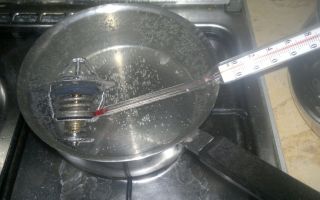Car thermostat: how to check, typical faults, symptoms
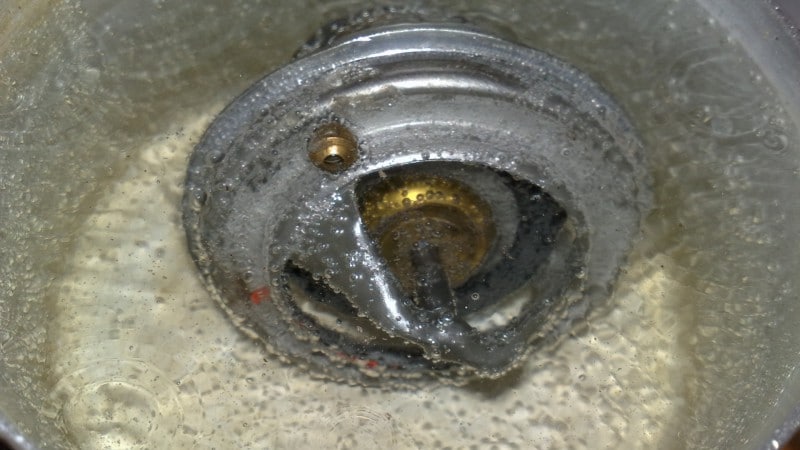

The thermostat is a small but important element of the car, which allows the driver to save on engine maintenance and fuel. Essentially, the thermostat is a temperature regulator in the cooling system. Due to it, the engine warm-up speed increases, and the car maintains the desired thermal conditions during operation.
The main task facing the thermostat in a car is to prevent the circulation of coolant through a large cooling circle until the engine warms up after starting.
After starting the engine, the antifreeze begins to circulate in a small circle until it reaches an operating temperature of approximately 90 degrees Celsius. Having warmed up, the coolant enters a large circulation circle and circulates through it until it cools down again (due to various reasons).
Through its actions, the thermostat maintains the operating temperature in the engine, preventing it from overheating or excessively cooling.
Symptoms of a faulty car thermostat
Considering the small number of functions assigned to the thermostat, it is quite easy to determine its malfunction. The fact that the car’s thermostat is completely out of order or partially fails to cope with the tasks assigned to it is indicated by the following:
- The car engine slowly warms up to operating temperature or often overheats;
- After starting a cold engine, the lower radiator pipe becomes warm in 2-3 minutes or even faster;
- At the moment of acceleration, the engine temperature needle drops sharply, and at the moment the engine stops and runs at idle speed, it rises again;
- The engine is warmed up, but the lower pipe remains cold, and the engine begins to boil.
Based on the above, we can conclude that if there are problems with engine cooling, you must first pay attention to the correct operation of the thermostat.
Basic thermostat malfunctions
The thermostat is a fairly simple device that rarely fails. If you have problems with your thermostat, they are most often associated with the following reasons:
- The valve for switching the liquid circulation from a large to a small circle has stopped closing tightly. Because of this, immediately after starting the engine, antifreeze circulates in a complete large circle, which is why warming up to an operating temperature of 90 degrees Celsius takes many times longer than with a working thermostat;
- The fluid circulation switch valve is stuck closed. In such a situation, the sensor to open it is triggered, but the damper cannot move. This leads to the fact that the antifreeze continues to circulate in a small circle even after the engine has warmed up. Accordingly, the engine parts do not receive the necessary cooling, and it overheats.
The thermostat is not expensive, but it is not to blame for all problems with engine cooling. That is why, before replacing the thermostat, you need to make sure that it is faulty.
How to check a car's thermostat
There are two main ways to check a car's thermostat. One of them is carried out without removing the part, but requires a pyrometer, and the second is simpler, but the element will need to be removed from the engine during the test.
Checking the thermostat without removing it from the engine
As you know, the thermostat housing is connected to the upper radiator hose, which is included in a large circle of coolant circulation. Accordingly, with the thermostat working, after starting the engine, the upper radiator hose should remain cold (slightly warm) for some time until antifreeze is released through it.
To check the thermostat without removing it from the engine, get a pyrometer (temperature measuring device). You may come across the opinion that the check should be done without a device, measuring the temperature with your hands, but this is quite dangerous, given the large number of moving parts when the engine is running.
Point the pyrometer at the upper radiator hose and start the engine (cold start). For two or three minus periods, observe the device’s indicators. Next, draw a conclusion about the serviceability of the thermostat according to the following rules:
- The hose was cold for two or three minutes (or its temperature rose slightly), and then quickly warmed up. This indicates that the thermostat is working properly, and it switched the coolant circulation from a small circle to a large circle after the engine has sufficiently warmed up;
- The hose initially warmed up slowly. In this case, we can say that the thermostat is stuck in the open position and the antifreeze does not circulate in a small circle;
- The hose did not begin to warm up quickly after two or three minutes. That is, the thermostat is faulty and it does not switch the coolant circulation from a small circle to a large one.
Important: While checking the thermostat, monitor the engine temperature on the instrument panel. If the thermostat is stuck and won't keep the coolant flowing, the engine will start to overheat, which can lead to expensive parts failure.
Checking the thermostat in the pan
A widespread and well-known way to test the thermostat yourself is using a saucepan. As you might guess, before diagnostics you will need to remove the thermostat from the car engine and bring it home. After this, do the following:
- Take a pot and fill it with water;
- Inspect the thermostat housing and read the technical information on it, which indicates at what temperature it should switch;
- Hang the thermostat in the pan so that it is immersed in water, but does not touch the walls and bottom of the container, that is, it comes into contact only with water;
- Start heating the water and put a regular thermometer in it to measure the temperature of the liquid;
- When the water approaches the thermostat switching value from closed to open, make sure this happens. Also compare the thermometer reading, recording the temperature at which the coolant circuit switching valve opens with the ideal values indicated on the device body.
If the valve opens when heating water, track its behavior when cooling the liquid, checking at what temperature it returns to its original position. Based on the data obtained, draw a conclusion about the functionality of the thermostat.
(299
Source: https://okeydrive.ru/termostat-avtomobilya-kak-proverit-ne-snimaya-s-avtomobilya/
How to check the thermostat without removing it from the car yourself?
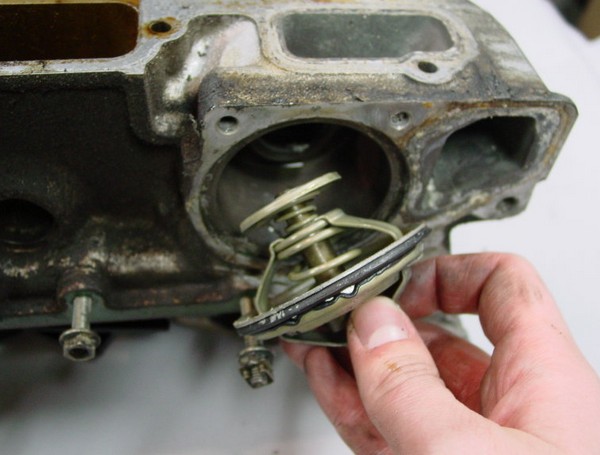
The advantage of diagnostics based on the degree of heating of the pipe is that you can check the thermostat without removing it from the car. But unlike the test at home, the method does not allow you to accurately estimate the opening temperature and response speed.
By controlling the degree of heating of the liquid, you can simulate changing the cooling and warming up modes of the engine several times in a row. The tricky thing about faults is that they can manifest themselves periodically. Therefore, if there are serious suspicions that the thermostat is not working properly, we recommend checking it only with a test at home.
Signs and consequences of a malfunction
What consequences should you prepare for if you failed to check the functionality of the thermostat in time?
- Poor performance of the car interior heater. If the valve is stuck open, coolant constantly circulates through a large circuit. Cooling of the radiator by the flow of incoming air and a general increase in the surface area that gives off heat leads to constant underheating of the engine. Because of this, not only does the stove heat poorly, but also the power decreases and fuel consumption increases.
- Motor overheating. A short-term excess of operating temperature can only lead to overheating of the piston rings, due to which their elasticity is lost. This will subsequently lead to loss of compression and increased oil consumption. Long-term operation in overheating mode is fraught with breakdown of the cylinder head gasket, thermal deformation of the cylinder head, loss of elasticity of the valve stem seals, and scuffing of the cylinder-piston group. As you understand, it is much easier to check the thermostat yourself than to pay for a major engine repair. If the cap of the expansion tank is faulty or cannot cope with the increased pressure in the cooling system, the tank may crack and the integrity of the radiator will be compromised in previously damaged areas.
Diagnosis at home
To check, place the thermostat in a container, then fill its body with boiling water. If the device is working properly, the valve should begin to open almost immediately. When the water temperature drops, the return spring will return the valve to its original position.
To most accurately test the thermostat, place a container with the thermostat immersed in water on the heater.
Using a thermometer, check at what temperature the valve begins to open.
The operating temperature range of the thermostat can be found in the repair and operating manual for your vehicle. Manufacturers often indicate this information directly on the thermostat housing.
RESOURCE
A mechanical thermostat is an extremely reliable car part with virtually nothing to wear out. It fails only due to natural wear and tear of the rubbing parts of the valve stem and guide. It is extremely difficult to predict the mileage of a car that will require replacement, but often this happens no earlier than 150-200 thousand km.
Electronically controlled thermostats fail much more often. In this case, the malfunction may be either in the heating element or in the control circuit from the electronic engine control unit (ECU).
Using low-quality coolant and driving on water significantly accelerates mechanical wear. Corrosion, deposits, and scale slow down the valve's performance and can cause jamming in the open/closed position.
ELECTRONIC THERMOSTAT
The design of the electronically controlled cooling system on Volkswagen, Skoda, and Audi vehicles requires the presence of a heater built into the thermostat valve sensing element. At certain engine operating conditions, the heater is used to accelerate the opening of the thermostat.
The self-diagnosis system is capable in many cases of determining the nature of the malfunction and displaying it in an error code. Using diagnostic equipment, you can check the functionality of the system without removing the thermostat from the car. By reading the fault code after the “Check Engine” appears on the dashboard, you can see:
- open circuit;
- short circuit to ground;
- Short circuit to +.
You can indirectly check the performance of the heating element by measuring its resistance. Usually this value is within 12-15 Ohms, but before checking it is better to clarify the normal resistance of a specific model of electronic thermostat.
If you know how to use a multimeter, you can test your heater at home. Infinite resistance will indicate a break in the heater. Also, in the resistance measurement mode, you can check the integrity of the control circuit wires. The ECU controls the heater using a PWM signal, so you won’t be able to check the signal at home without an oscilloscope.
Source: https://neauto.ru/kak-proverit-rabotosposobnost-termostata-v-avtomobile-svoimi-rukami/
How to check the thermostat for malfunctions?
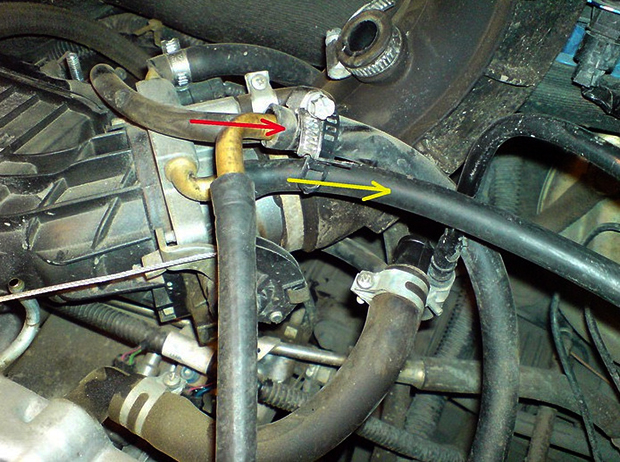
The engine is the most important unit of a car and, like any complex mechanism, it has the concept of operating temperature. It is by achieving this that the internal combustion engine is able to operate in optimal mode with a minimum degree of wear of parts.
However, it should be understood that overheating the engine does not bring any benefit and can also cause various types of breakdowns.
It is to maintain optimal temperature conditions that each engine is equipped with a small but irreplaceable part, a thermostat.
In the photo - thermostat
Thermostat operating principle
By and large, a thermostat can be compared to an automatic engine temperature controller, which allows you to save time for warming up the power unit and the fuel consumed during this process. Each motor has two cooling circuits: small and large.
The part prevents antifreeze from penetrating into the large circle until the internal combustion engine reaches normal temperature conditions for further operation. As a rule, the optimal temperature regime of modern units is approximately 80 – 90°C.
When this mark is reached, the thermostat opens and the coolant begins to circulate in a large circle.
Thermostat operating principle
If for some reason the engine cools down, the thermostat again blocks the flow of fluid until the temperature rises to the optimal value.
The thermostat is a valve that opens when a certain temperature is reached. Its device is quite simple and has nothing to do with electronics.
Device
Inside the part there is a special wax, which, under the influence of high temperature, begins to expand and compresses the rubber membrane. That, in turn, displaces the metal rod that opens the valve. In case of cooling, the thermostat again blocks the circulation of antifreeze in a large circle using a return spring.
Troubleshooting
Problems with the functioning of the thermostat are extremely rare, and its service life on modern cars is more than ten years. However, despite the simplicity of the part, it can still malfunction. At the same time, you should not hesitate to replace the valve, since overheating of the engine can cause serious and very costly breakdowns.
If the thermostat nevertheless begins to work with errors, then most often this is due to the following reasons:
• The valve does not close tightly. In this regard, the coolant begins to circulate in both cooling circles, which significantly increases the time it takes for the power unit to warm up to operating temperature. This case cannot be considered critical, since there is no detrimental effect on the engine, but the amount of fuel spent for warming up increases significantly.
• Thermostat wedge is closed. In this case, the circulation of antifreeze occurs only in a small circle. In this case, the internal combustion engine does not receive sufficient cooling and overheats. Often, because of this, the geometry of the cylinder head is disrupted, which cannot be restored, but only requires replacement.
Identifying the malfunction is quite simple: if the engine warm-up time has noticeably increased or the engine temperature indicator is constantly at the peak level, it is necessary to pay attention to the cooling system.
It is worth understanding that unstable cooling operation of the unit is not necessarily related specifically to the thermostat.
Therefore, you should figure out what exactly the problem is before you buy a new part, even though a new thermostat is inexpensive.
The serviceability of the valve can be determined in two ways: non-removable and under thermal influence in a separate container.
Without resorting to dismantling the thermostat, it is rare to establish with certainty that the problem lies there, but at the first symptoms you can use this method. To do this, open the hood of the car and start the engine, and then feel the radiator pipes.
If they become warm almost immediately after starting, even before the indicator needle deflects, then this indicates that the valve is not closing tightly.
In addition, the thermostat may become stuck in the open position. This happens rarely, but the possibility cannot be ruled out.
In the event that the valve does not open when overheated, the radiator channels will remain cold even after reaching a critical temperature.
You can be sure that a part is faulty by heating it outside the vehicle engine. To do this, the thermostat is immersed in a metal container with water. An ordinary kitchen pan is quite suitable.
Checking at home
After putting it on the fire and waiting for the water to boil, you should observe the behavior of the valve. A working thermostat must work when heated above 90°C - the rod will move and the part will increase in size.
Causes of failure
Most often, signs of valve failure are caused by a violation of its integrity. The use of low-quality coolants or their untimely replacement can cause corrosion of both the cooling system circuit lines and the thermostat itself. Rust begins to interfere with the free movement of the rod, causing the functionality of the part to be impaired.
Rust on thermostat
In addition, prolonged heating of the power unit can cause failure. Some motorists prefer to idle the engine for about ten minutes.
There is no real benefit to this, but rather the opposite.
Experienced motorists recommend starting to drive without warming up at speeds of less than two thousand, and after the temperature has risen above 70°C, continue driving with higher tachometer readings.
Valve replacement
A failed thermostat cannot be repaired and must be replaced. You can do this yourself without resorting to the help of a car service.
The first step is to drain part of the coolant, antifreeze or antifreeze, into a separate clean container. This can be done using a special tap on the radiator or by disconnecting the lower hose. With a normal upper position of the valve, there is no need to completely drain the liquid, the main thing is that its level is below the part itself.
After the liquid has been drained, you can begin to dismantle the failed thermostat. To do this, carefully disconnect the upper hose from the valve body.
Remove the pipe, placing a bottle to drain the liquid. Using the example of Nissan Almera N16
It is recommended to plug the open hole of the hose with any available object to prevent dirt from getting into it.
Next, unscrew the nuts or bolts securing the housing. Perhaps after this it will not be possible to remove it easily, due to the fact that it has become stuck.
In this case, you should not pick at the joints with a screwdriver, but rather simply knock on the body with a wooden block.
Remove the cover
Once the housing has been removed, the old thermostat can be removed without any effort. Its hole, as well as the hose hole, should be closed so that no contaminants penetrate into the cooling system.
Before installing the new valve, it is important to remove all traces of the old gasket from the body using a putty knife. After this, you can install the thermostat. Some models have differences in the location of the part.
Most often, the manufacturer puts an arrow that should be directed towards the radiator.
Remove and replace thermostat. Photo — Drive2.ru
Before fixing the housing, it is recommended to lubricate the circuit with sealant. The nuts or bolts of the housing must be tightened alternately to avoid distortions; it is also worth remembering that overtightening them is undesirable.
Next, you should reconnect the hose to the body and tighten it with a clamp. When using screw clamps, it is better to use a new one, and not the one that was installed before replacement. At the last stage, coolant is poured into the system.
You can also use the one that was previously drained.
After the work has been done, it is important to check that there are no leaks at the joints. To do this, it is worth starting the engine in idle mode and observing its operation for several minutes.
Source: https://avtoexperts.ru/article/kak-proverit-termostat-na-neispravnosti/
How to check the thermostat without removing it from the car
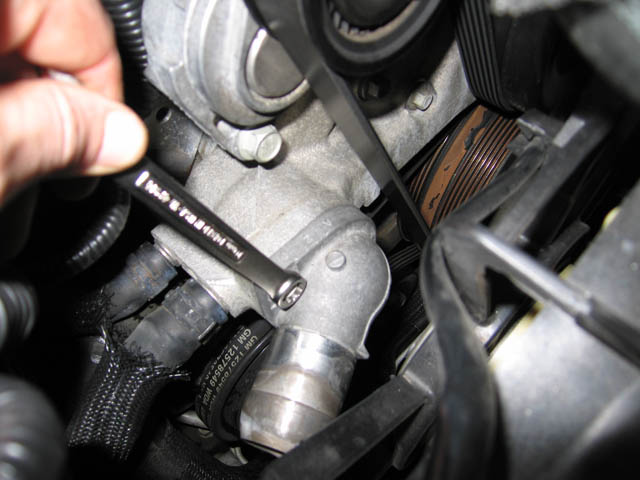
Sometimes the car's cooling system fails. The engine temperature arrow on the dashboard goes off scale after a few minutes of warming up. And sometimes the opposite happens - the temperature, especially while driving, does not reach the operating value of 90 degrees.
Content
These are all sure signs that it's time to check the important device that controls coolant flow. Many people know that this completely closed assembly consists of a valve and a heat-sensitive substance. The latter, when heated, opens a large circuit - the radiator - through the coolant valve.
Without dismantling the device, this is the only way to correctly diagnose it.
- Start the engine, then wait two minutes.
- Touch the hose directed from the device being tested to the radiator.
- If the hose is hot, the device is faulty; most likely, the valve never closes.
- If the hose remains cold even after 5 - 10 minutes of warming up, and the temperature on the panel is already more than 90 degrees, the unit is also faulty. Most likely, the valve, on the contrary, does not open.
Also read about replacing the fuel pump filter and how to flush a car radiator at home.
Possibility to do without removing the device
Next, we’ll figure out how to check the thermostat on VAZ cars. Let's start with the "classics". Here are the instructions for the VAZ 2106 car.
- Initially, you need to determine that the coolant level is normal, that the temperature arrow on the instrument panel works, and that the belt driving the antifreeze pump (pump) is tensioned normally.
- Next you need to start the engine and warm it up. If more than five minutes have passed and the temperature needle has not risen above 70 degrees, you should touch the return pipe from the radiator. If it is slightly warm, it means that the coolant immediately enters the large system circuit. Consequently, the valve of the device is constantly open.
- If the engine overheats after five minutes or more, you need to touch the upper radiator hose.
Suppose it turns out to be cold - this means that the valve of the device being tested is jammed.
This instruction describes how to check the serviceability of a thermostat that has not been removed from the car.
But the following describes the procedure - how to check a removed thermostat at home.
- Make sure that the unit valve is closed at room temperature. If not, the device is faulty.
- Hang the device under test using a harness on some bracket, and the device should be inside a container of water, without contact with the walls. After heating the water, just before boiling, the valve should open. Its incomplete opening is acceptable.
- Allow the device under test to cool. In this case, the through element must be closed.
If the device turns out to be broken, it is better to replace it completely.
This instruction describes how to diagnose the operation of a dismantled device. However, to complete the picture, let’s add a few words about dismantling the unit. To do this, use a screwdriver to loosen the clamps of the three pipes suitable for the device. Then pull out the pipes and dismantle the necessary device, placing the container under the antifreeze leak.
During reinstallation you will have to add coolant.
What to do with front-wheel drive and Kalina
Next, let's talk about front-wheel drive VAZs. First of all, let's figure out how to check a suspicious thermostat on a VAZ 2109. This device should allow antifreeze access to a large circle when it reaches a temperature of 87 degrees.
- To diagnose the element directly on the car, you first need to start the engine and wait until the panel arrow shows 90 degrees.
- Then you also need, as has already been indicated, to touch the pipes - the one going from the element being tested to the radiator, as well as the one going from the radiator to the engine. They should be equally warm. If the hose from the unit being diagnosed to the radiator is cold, the device is faulty.
- But suppose the tubes are warm and the piston unit overheats, you need to look at the radiator fan switch and pump - are they working properly?
- It's another matter if the engine does not reach 90 degrees. You should also feel the hoses. If the pipe from the device being tested to the radiator is warm, the device being tested is faulty, and the antifreeze constantly circulates in a large circle.
Sometimes other troubles happen. Let's describe it using the example of a more modern front-wheel drive Lada. We will enclose the information within the framework of instructions on how to check a thermostat that has not been removed on a VAZ 2114:
- Let’s assume that the temperature arrow on the panel shows more than 90 degrees, and a little time has passed since the engine started;
- we open the hood, first of all we remember how to check whether the thermostat is working or not, after which we touch the pipe going from the device being diagnosed to the radiator;
- we find out that the pipe is warm, in addition, the pipe going from the radiator to the engine is also warm;
- turn off the engine, let it cool, determine that the pump drive belt tension is normal, start the engine again;
- we find out that the tube from the element being diagnosed to the grid cooler is cold;
- wait for the fan to warm up and start working;
- we conclude: the car’s temperature sensor on the cylinder block is faulty.
It remains to add that the description of how to check a thermostat that has not been removed on a VAZ 2110 will be similar to the previous instructions. So we'll leave it out here.
Now let’s look at how to check the thermostat on Kalina yourself.
- You must first start the engine. This method shows how to check the thermostat on Kalina without even removing it. However, the method is identical to those previously described - you just need to touch the pipe from the element being diagnosed to the cooling grid assembly. Up to 90 degrees it should be cold, after 90 - warm.
- For more accurate diagnostics of the device, we remove it from the car.
- To dismantle, first drain the antifreeze from the system.
- We remove the recirculation valve and the mass air flow sensor.
- Remove the air filter housing.
- Having loosened the clamps, we remove 4 pipes from the system link we need.
- After unscrewing the nut, remove the ground wire.
- Having unscrewed the fastenings, we remove the device under test from the mounting socket.
Next, we’ll figure out how to check whether this Kalina thermostat is working at home. To do this, it is enough:
- lower the device inside a large volume of water in the pan, so that it does not touch the walls;
- turn on the stove, heat this water;
- when boiling, the valve will open;
- Allow everything to cool; when the device cools down, the valve will close.
If any of the above does not occur, the unit is faulty.
What not to do
Well, so far several methods have been described on how to check the functionality of a car thermostat. But you should also definitely indicate the incorrect options for how car enthusiasts can check the thermostat.
For clarity, this information is summarized in a table. Here she is.
| Way | What is it? | Why is it dangerous? |
| Dismantling the home inspection device immediately after the engine is running. | On a warm engine, the device is removed in order to test it at home. | You can get serious skin burns from hot antifreeze. |
| Probing the radiator after warming up the engine. | To diagnose a unit, they do not touch the pipe leading from it to the grate cooler, but the cooler itself. | You can get burned on a hot metal surface. The hot surface of the pipe is safe for the skin. |
Here are the most common mistakes made by car enthusiasts who do not know exactly how to check the thermostat on a car.
Return to top
So, above, descriptions were given of how to check the operation of the thermostat directly on the car, as well as after dismantling. Many car enthusiasts can learn something for themselves from this information.
Now look at replacing the power steering fluid on a 2002 Galaxy and replacing the rear crankshaft oil seal on a cl9 Accord.
Source: http://DaciaClubmd.ru/repair/engine/kak-proverit-termostat
How to check the thermostat on a VAZ-2110: opening temperature
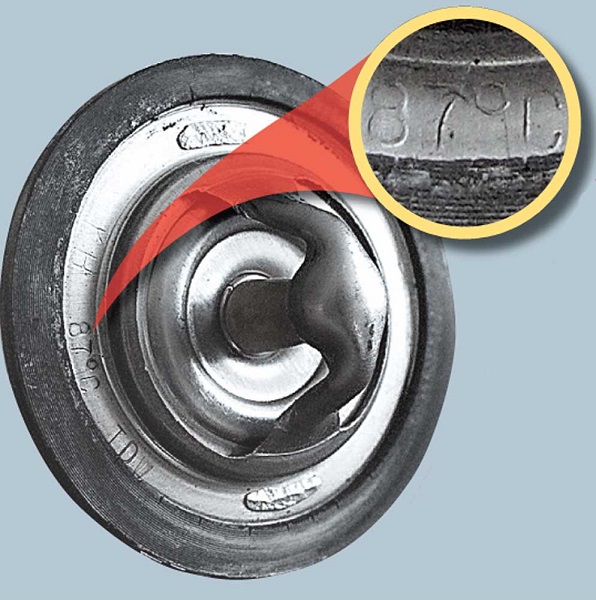
It is he who regulates the direction of antifreeze flows in the system, which can move in a large or small circle. Failure of the thermostat can lead to overheating of the motor, which may even jam. At best, the engine simply will not reach operating temperature.
In order to keep the engine from overheating, you need to know all the ways to check the functionality of the thermostat, which can be used without removing the device from the car.
Reasons why a thermostat may fail
The thermostat is responsible for maintaining the optimal temperature of the car engine.
An experienced driver can determine a malfunction of the VAZ-2110 thermostat for indirect reasons. They can be divided into the following points:
- Thermostat takes too long to heat up . This can happen due to unstable operation of the engine, which produces strong vibration. This can damage the valve of the device, causing antifreeze to get inside the thermostat. As a result, the device will work more slowly.
- The valve may also open earlier than expected . As a rule, this is the result of antifreeze getting into the element responsible for coolant temperature.
- The thermostat may open with a delay . Most often, this occurs due to leakage of the filler, which is responsible for the valve opening temperature.
- The thermostat works correctly, but the engine constantly overheats . This may occur due to the coolant moving only in a small circle. The engine may also overheat due to cracks in the pipes or radiator.
- Mechanical damage to the thermostat valve can also prevent it from working correctly.
- Manufacturing defects . Unfortunately, domestically produced spare parts are often produced with factory defects, which can lead to a whole series of unnecessary work, since after changing the thermostat, the car owner will look for the cause of the breakdown anywhere, but not in it.
- Destruction of the rubber seal. If oil gets into the coolant, it can quickly render all rubber parts and pipes that were in contact with the oil unusable.
Oil causes seals to break down.
How to solve problems on the VAZ-2110?
Most thermostat problems can be resolved on your own. As a rule, VAZ-2110 owners do exactly this.
It happens that, despite the normal operation of the thermostat, the temperature of the coolant in the engine is constantly above normal. If you are sure that the thermostat is working properly and the cooling radiator is new, clean and undamaged, then you should replace the device with another one.
Loosen the clamps of the radiator outlet hose. Loosen the clamps of the inlet hose of the pump pipe.
If the device opens late, then you need to check the entire system for the presence of coolant in it. It happens that the tank is full, and air pockets in the system interfere with the full circulation of antifreeze.
Video on how to repair a VAZ-2110 thermostat
Thermostat valve malfunction
The thermostat may open early due to high pressure in the cooling system. Excessive pressure is very dangerous, it can lead to rupture of pipes or the radiator in the best case, and seizure of the engine in the worst case .
The thermostat valve may open early in the following cases:
- Increased engine speed.
- Failure of the thermostat spring.
The spring may cause the valve to operate early.
- Problems in the cooling system.
This last point is extremely broad. The reason may be either an insufficient amount of antifreeze in the system or a failure of the radiator, pipes, and so on.
Long warm-up
VAZ-2110 drivers often encounter the problem of the engine warming up for too long. This may be due to the following reasons:
- The thermostat valve does not close completely.
The reason for the engine taking a long time to warm up is a stuck valve.
- The valve disc is damaged.
- The thermostat is installed incorrectly or has changed its position as a result of manipulations under the hood.
How to check the thermostat without removing it from the car
The check occurs according to the following algorithm:
- A cold engine starts and warms up within 2–3 minutes. At this time, the coolant should only flow in a small circle.
- To check that the antifreeze is moving in this way, you need to touch the pipe that goes to the top of the main cooling radiator. It should be cold, this indicates that the thermostat valve is closed.
You can determine if the thermostat is faulty without removing it from the car.
- As soon as the engine temperature rises to 90 degrees, the valve should open and the antifreeze will flow in a large circle. If this does not happen, the thermostat valve is stuck and will not open.
Otherwise, the valve may become stuck open. Then the antifreeze will circulate in a large circle immediately after starting the engine. This will never lead to overheating of the engine, but will significantly affect fuel consumption, since the operating temperature of the engine will be reached over a longer period of time.
Video about checking the thermostat without removing it from the car
Stuck in intermediate state
It is impossible to check the thermostat for its 100% functionality without removing it. But it is possible to determine the main damage in this way.
Video on how to check the VAZ-2110 thermostat with your own hands
Source: http://carfrance.ru/proveka-termostata-na-vaz-2110/
How to check the engine cooling thermostat
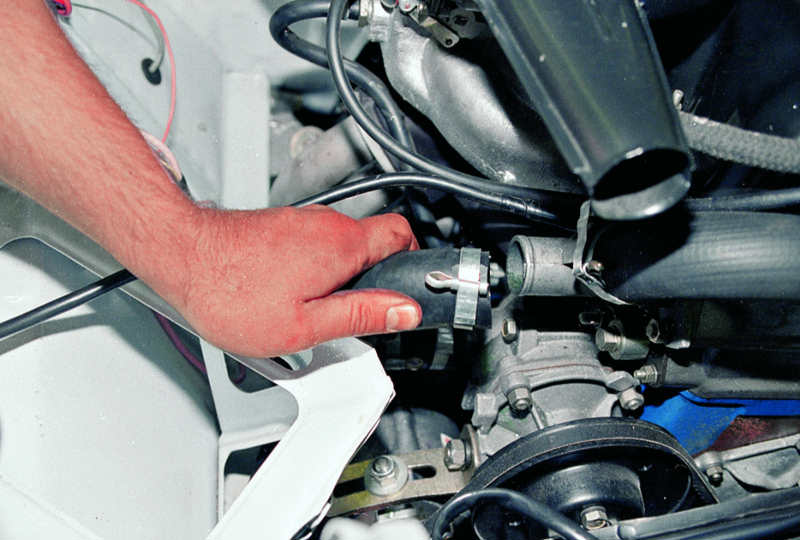
The functioning of the entire cooling system depends on the health of the thermostat, because it is the one that does the job of regulating the temperature of the coolant.
When the car engine warms up too quickly, the electric fan turns on almost immediately, and the coolant temperature sensor needle inexorably approaches the red zone, threatening to overheat the engine, there is every reason to talk about abnormal operation of the cooling system. Very often the cause of this malfunction is the thermostat.
Drivers also make mistakes with the thermostat if the engine slowly warms up to operating temperature, and the temperature sensor needle is rooted to the spot at the beginning of the scale.
Thermostat operating principle
The purpose of the thermostat is to block access of coolant to the radiator until its temperature reaches a certain value (from 85 to 950 C).
This task in most thermostats is accomplished using a valve leading to the lower radiator pipe.
Such a valve is connected by means of a pin to a cylinder filled with industrial wax, the melting point of which is 850 C. When the coolant is heated to the specified temperature, the wax also heats up to the same temperature.
As it changes from solid to liquid, it expands significantly, pushing a pin out of the cylinder that opens the valve.
As a result, the coolant begins to circulate through a large circle of the cooling system, releasing most of the heat through the radiator and cooling.
As the engine temperature drops, the wax in the thermostat cylinder decreases in volume, closing the valve and circulating coolant through a small circle of the cooling system.
Checking the operation of the thermostat on a car
To check the thermostat, start the car engine and warm it up to normal temperature. 1-2 minutes after starting, when the coolant temperature gauge needle has just begun to deviate from the edge of the scale, check the heating of the pipes leading to the radiator.
The lower pipe should remain cold, and the upper pipe should gradually warm up. The pipe leading to the interior stove should also be moderately warm.
As the engine warms up, the upper radiator hose should become hot and the lower hose should remain cold.
When the thermostat response temperature is reached (applied to its body or indicated in the passport), the lower radiator hose will become warm, and then hot.
This is evidence that the thermostat valve is operating. In warm or hot weather, the electric fan should also turn on. This is the normal operation of the thermostat.
If, during the process of warming up the engine, both radiator pipes become warm at the same time, this indicates that the thermostat valve is constantly in the open position, starting the circulation of coolant throughout a large circle of the cooling system.
This option is also possible - the engine has warmed up, the electric fan has turned on, but the lower radiator hose remains cold. In this case, the thermostat valve remains constantly closed and does not open even when the coolant heats up, allowing it to circulate in a small circle of the cooling system.
Both of the latter options clearly indicate that the thermostat is faulty and must be replaced.
Checking the functionality of the removed thermostat
It's very easy to check if your thermostat is working properly at home. All you need for this is a saucepan with boiling water.
Place the thermostat in boiling water and wait a few seconds for it to heat up. If it is in good working order, you will clearly see how the rod moves and the thermometer valve opens.
In the same way, the closing of the valve will clearly occur if the thermostat is cooled under running water or in a saucepan with cold water.
If, as a result of home testing, it turns out that the valve does not open and/or close, then the thermostat is faulty.
Engine overheating can occur not only due to a faulty thermostat.
In some cases, insufficient circulation of coolant can be caused by failure of the water pump (pump) or “airing” of the cooling system due to improper replacement of coolant.
Source: https://goodmaster.com.ua/avtomobil/kak-proverit-termostat.html
How to check if the thermostat is working properly
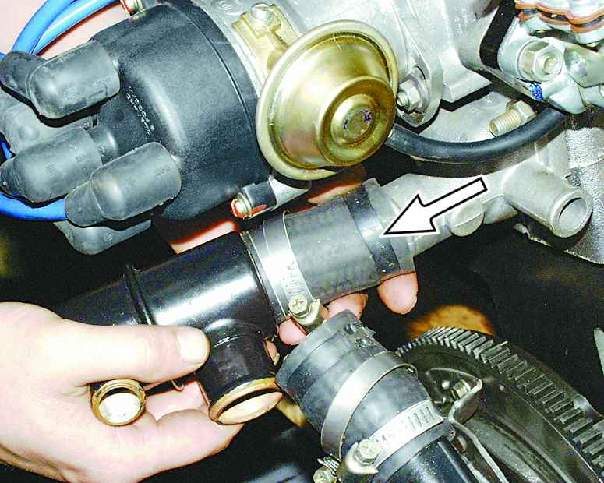
The task of the thermostat, as one of the devices that are responsible for maintaining the optimal temperature regime for the operation of the internal combustion engine, is to direct the coolant along the large or small circuits of the cooling system, depending on the temperature.
Problems with the device appear after starting a cold engine if the valve is stuck in the half-open or open state. A working device warms up at zero temperature in 5-10 minutes. The half-open state of the valve is fraught with “boiling” of the engine in difficult road conditions.
How to check if the thermostat is working properly? There are two options: determine the serviceability of the thermostat directly on the car or remove it. Two things will help you understand how to check the thermostat without removing it:
- coolant;
- thermometer.
Unstable engine temperature may cause the thermostat to be checked.
First start the engine, check the heating condition of the upper and lower pipes by touch.
The upper pipe should begin to warm up after the instrument panel thermometer needle reaches 60-70 °C. If the heating occurs at the same time, you will need to replace the thermostat. This is a fairly simple way to determine the health of the device through the temperature difference in the exhaust and intake valves, which discharge and supply coolant to the car radiator.
Thermostat device diagram.
The second method is a little more complicated. You need to open the filler neck and make sure that the coolant is filled according to the norm, that is, its level is not higher or lower than recommended. Then the engine starts and a thermometer is placed in the filler neck. Please note that you will need a device that is capable of measuring temperatures above 100°C.
If at first the thermometer readings remain unchanged, but upon reaching the operating temperature they begin to increase sharply, the serviceability of the thermostat is considered confirmed. If the thermometer readings increase gradually as the engine warms up, the device is clearly faulty.
Please note that the second method is suitable for those cars that contain a filler neck on the radiator.
The most reliable way to determine if the thermostat is working is by removing it from the car. This is a much more accurate method. With the thermostat removed, the valve fit is checked. The spring must be pressed tightly against the body of the device.
For the removable method, you will need a technological solution made of equal parts of water and ethylene glycol and a thermometer with a scale graduation above 100 °C. The thermometer and thermostat are placed in the solution. It is important that the devices do not touch the walls or bottom of the container. Heat the solution to 87 °C, carefully controlling the process.
At the specified temperature, the thermostat valve should operate, and at 102 ° C the valve opens completely.
The water temperature must be at least 78 degrees.
If you are not comfortable using ethylene glycol, you can heat the appliances only in water. The actuation and opening temperature of the valve in this case will be 83° C and 98° C, respectively. If the thermostat valve opens or operates at other values, the device is considered faulty.
Check the actual results obtained with those stated in the manufacturer's specifications. They may differ for different engines, although they are usually in the range of 70-95° and 100-105° C, respectively. The nominal full opening temperature value is often stamped on the thermostat housing. The full stroke of the thermostat valve stem is 5-8 mm.
Electronically controlled thermostats are checked by diagnostic scanners connected to the engine ECU.
General recommendations
Not only a half-open jammed valve state can be dangerous, but also a closed one. The latter option is fraught with engine overheating in any driving mode, any positive temperature, and even in slight frosts.
If the temperature-sensitive element has aged, the valve opens later and later, and the temperature of the power unit is maintained at an increasingly higher level. Violation of the temperature regime greatly wears out the engine when it overheats; when the liquid boils away, the engine can jam, and if it is not warmed up enough, excess fuel consumption occurs.
http:
An ordinary driver may suspect a thermostat failure due to the reduced efficiency of the stove if slightly warm air is blowing from it. However, you should not immediately blame the thermostat; at a minimum, you should check the coolant level, the force and condition of the drive belt, and the proper functioning of the temperature meter.
If all the above-mentioned suspected reasons are in perfect order, only then should you start checking the thermostat using the described method. Diagnosing a removed thermostat is much more effective and accurate, but the choice is yours. If the thermostat is faulty, it should be replaced with a new one. Never attempt to drive a vehicle with the thermostat removed.
This is fraught with a break in the feedback of the on-board processor, an increase in the toxicity of exhaust gases and an excessive increase in fuel consumption.
Source: https://davaistroy.ru/kotly/kak-proverit-ispravnost-termostata.html


